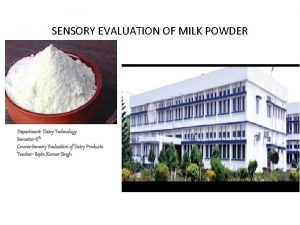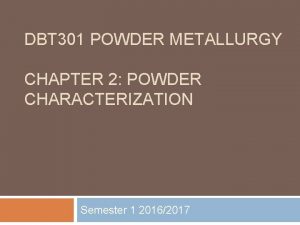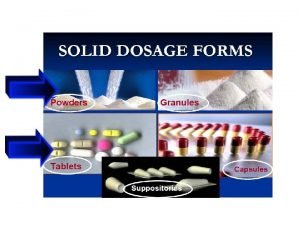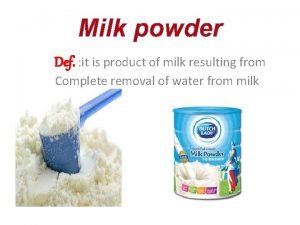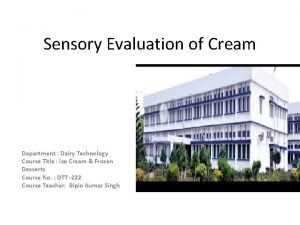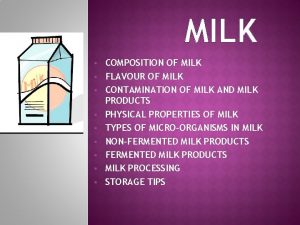SENSORY EVALUATION OF MILK POWDER Department Dairy Technology












- Slides: 12

SENSORY EVALUATION OF MILK POWDER Department- Dairy Technology Semester-6 th Course-Sensory Evaluation of Dairy Products Teacher- Bipin Kumar Singh

Introduction • Sensory evaluation of milk powder is important for determining the shelf life of the product. Descriptive sensory analysis method has been used to identify and quantify flavors in several dairy products.

WMP • Sensorial Characteristics of milk powder Flavour: Stale, storage, old, Rancid, Oxidized/tallowy, Scorched • Physical Characteristics of WMP o Body and texture: Lumpy, Caked o Colour of WMP: Browned or darkened, Scorched, Lack of uniformity

Skim milk powder • Skim milk powder (SMP) Flavour: Stale, storage, old, Scorched, Oxidized/ tallowy • Physical Characteristics of SMP Colour of SMP

Malted milk • Flavour: Malted milk, being composed in large part of maltose and dextrose, has a definitely sweet taste. It should have a distinct flavour of malt. The product should be judged for its lack of malt flavour and for oxidized flavour defect. • Body and texture: Malted milk has a coarse and grainy texture unlike the fine texture of spray dried milk. While judging, product must be examined for possible stickiness and formation of cakes because of its affinity for water.

Sensory Evaluation procedure • Begin with the examination of the powder container for its appearance and seal. A perfect package should be properly sealed and unsoiled. • Open the container and immediately assess the product for its odour. • Take out the sample in sufficient quantity in a petri plate or any other convenient and coverable container. • Judge the product for its appearance and then for flavour by taking a small quantity in the mouth and manipulating it inside mouth by using the tongue. Expel the product from mouth. • To consolidate the information obtained as above, evaluate the product further by reconstituting it by adding 13 g whole milk powderor 1 Og skim milk powder to 100 ml. distilled water (temperature of


Contd. . water should be 30 -35°C for skim milk powder and 40 -45°C for whole milk powder) and mixing it vigorously for 90 sec with the help of an electric mixer. • Before evaluating the reconstituted milk, allow it to stand for 30 min. for blending of flavours which would help the judge in determining more accurately the true flavour; otherwise, freshly prepared fluid milk often gives a slightly chalky, watery or cooked taste. • Instant dry milk can be reconstituted by adding the proper amount to cold distilled water with vigorous shaking, allowing the mixture to stand in the container for a minimum of 15 min. and then gently mixing again before judging.

Contd. . • Take the reconstituted milk (about 50 ml. ) in a 100 ml beaker or a testing glass. For flavour evaluation, take a generous sip and roll it in the mouth and note the flavour sensation. • Sometimes the after-taste is enhanced by breathing in fresh air very slowly through the mouth and then exhaling it slowly through the nose.

Contd. . Shake the milk and place the nose directly over the container immediately after the milk has been shaken and note the presence of any off-odour by taking a full 'whiff of the air. • The flavour impression obtained on the dry product as such should be correlated with that on the reconstituted product before giving the score. • Following the above procedure it would be convenient to keep the product ready in both dry as well as reconstituted forms before starting its examination. • Indicate the scores on different attributes in the Evaluation Card. The hints given in Scoring Guide will aid the judge to score the product properly. •


 Sensory evaluation of dairy products
Sensory evaluation of dairy products Milk for toddlers with milk allergynon dairy
Milk for toddlers with milk allergynon dairy Product life cycle of cadbury ppt
Product life cycle of cadbury ppt Objectives of milk dairy visit
Objectives of milk dairy visit Bestmilk
Bestmilk Dairy power mango lassi
Dairy power mango lassi Benjamin cadbury
Benjamin cadbury Milk yield and composition in dairy cows ppt
Milk yield and composition in dairy cows ppt Dairy process engineering
Dairy process engineering Dusting powder should pass through sieve number
Dusting powder should pass through sieve number Advantages of granules
Advantages of granules Powder characterization in powder metallurgy
Powder characterization in powder metallurgy Bulk powders examples
Bulk powders examples
